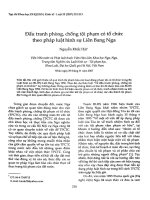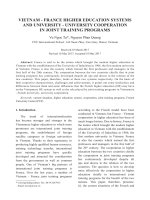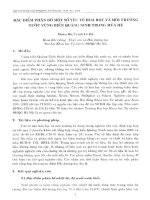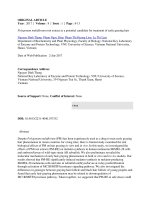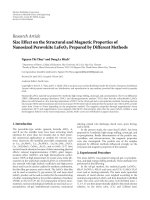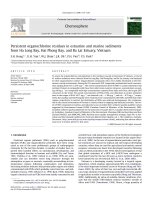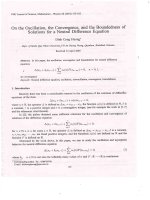DSpace at VNU: Associations between alcohol use disorders and adnce to antiretroviral treatment and quality of life amongst people living with HIV AIDS
Bạn đang xem bản rút gọn của tài liệu. Xem và tải ngay bản đầy đủ của tài liệu tại đây (253.36 KB, 7 trang )
Tran et al. BMC Public Health 2014, 14:27
/>
RESEARCH ARTICLE
Open Access
Associations between alcohol use disorders and
adherence to antiretroviral treatment and quality
of life amongst people living with HIV/AIDS
Bach Xuan Tran1*, Long Thanh Nguyen2, Cuong Duy Do3, Quyen Le Nguyen4 and Rachel Marie Maher1
Abstract
Background: We examined the association of alcohol use disorders (AUD) with adherence to and health-related
quality of life (HRQOL) outcomes of antiretroviral treatment (ART) for HIV/AIDS patients.
Methods: A cross-sectional multi-site survey was conducted in 468 drug users and 648 non-drug users (age: 35.4 ±
7.0 years; 63.8% male) in 3 epicentres of Vietnam. AUD, ART adherence, and HRQOL were measured using the
Alcohol Use Disorders Identification Test - Consumption (AUDIT-C), the self-reported Visual Analogue Scale (VAS),
and the World Health Organization Quality of Life instrument (WHOQOL-HIV BREF).
Results: 35.0% of drug users were hazardous drinkers, compared to 25.9% of non-drug users. 22.3% of drug users
engaged in binge drinking, and 25.9% reported suboptimal ART adherence. Adjusting for propensity scores of AUD,
patients who had either at-risk or binge drinking behaviour were about twice as likely to be treatment
non-adherent as those who did not have AUD. Hazardous drinkers reported small to medium decrements in the
Performance, Physical, Social, Spirituality, and Environment quality of life domains. Binge drinkers had a slightly
higher score in Social dimension.
Conclusion: AUD is prevalent and negatively affecting adherence to and HRQOL outcomes of ART services in
injection-driven HIV epidemics. Screening and intervention are recommended for AUD, especially during the stable
periods of ART. Other social and psychological interventions might also enhance patients’ responses to and
outcomes of ART in Vietnam.
Keywords: Alcohol use disorders, HIV/AIDS, Antiretroviral treatment, WHOQOL-HIV, Adherence, Vietnam
Background
In many Asian populations, hazardous alcohol use is
found to be associated with the spread of HIV infection
and substantial unfavourable outcomes of HIV/AIDS
treatment [1-4]. At-risk drinkers are more likely to engage
in unprotected sex, which contributes to the transmission
of HIV and other sexually transmitted infections [1].
Among HIV/AIDS patients, hazardous drinkers adhered
less to antiretroviral treatment (ART) than other patient
groups, resulting in poorer immunological and virological
treatment outcomes [5]. Alcohol use is also found to be
associated with lipodystrophy and exacerbate antiretroviral
* Correspondence:
1
Institute for Preventive Medicine and Public Health, Hanoi Medical
University, Hanoi, Vietnam
Full list of author information is available at the end of the article
therapy - induced neuropathic pain in patients with HIV/
AIDS [6,7]. Moreover, it has a direct association with depression and HIV disease progression [8]. Interventions
for individuals with substance abuse - including alcohol are therefore necessary measures to control the spread
and reduce the impact of HIV/AIDS.
The HIV epidemics in Asia are largely driven by drug
injection, and more than half of all people living with
HIV/AIDS in these countries are injection drug users
[4]. Treatment of opiate drug use during ART has been
implemented in some settings, such as the integration of
methadone maintenance with ART services [9,10]. However, while a high prevalence of alcohol use disorders
(AUD) has also been observed among drug users, its
negative impact on the outcomes of ART is not fully
recognized [11-16]. This lack of knowledge may have a
© 2014 Tran et al.; licensee BioMed Central Ltd. This is an open access article distributed under the terms of the Creative
Commons Attribution License ( which permits unrestricted use, distribution, and
reproduction in any medium, provided the original work is properly cited.
Tran et al. BMC Public Health 2014, 14:27
/>
couple of possible explanations. First, alcohol is a legal
commodity which is culturally accepted in many Asian
cultures [11]. In addition, few studies in Asia have quantified the impact of AUD on HIV/AIDS treatment outcomes, and empirical evidence of large injection-driven
HIV epidemics is still limited.
Vietnam has a concentrated HIV epidemic, which
emerged initially in drug using populations. It is estimated that 320,000 people have contracted HIV, 70% of
which are drug users [17]. Antiretroviral treatment services have been rapidly scaled up in the country since
2006, and covered 60% of patients with HIV who were
in need of treatment by 2012 [18]. Previous works have
shown various factors that influenced adherence to and
outcomes of antiretroviral treatment in the Vietnamese
settings [18-23]. This included, for instance, avoidance
of HIV testing, deferred antiretroviral treatment, heroin
use, lack of social and familial support, stigma and discrimination. Although one third of HIV/AIDS patients
are hazardous drinkers, the magnitude of AUD’s impacts
on HIV treatment outcomes have not been determined,
and not any intervention of alcohol use among patients
with HIV/AIDS has been implemented [11]. In this study
we sought to examine the association of AUD on antiretroviral treatment adherence and health-related quality
of life (HRQOL) of HIV/AIDS patients receiving treatment from multiple ART clinics in three epicentres of
Vietnam. The study provides a baseline for evaluating effectiveness of potential intervention strategies to reduce
alcohol consumption among HIV/AIDS patients.
Methods
Study design and participant recruitment
This study was a part of the 2012 HIV Services Users
Survey, which was conducted in seven clinics in three epicentres of Vietnam: Ha Noi, Hai Phong, and Ho Chi Minh
City. The survey included inpatients and outpatients who
were attending ART clinics in three district health centres,
three provincial hospitals, and one central hospital. A detailed description of survey design and sampling has been
presented elsewhere [11,24,25]. In short, we purposively
selected facilities based on the following criteria: 1) the
sample included central-, provincial- and district-level
hospitals or health centres 2) they have been providing
ART services, and 3) a sufficient number of HIV/AIDS patients attend each clinic. All HIV-positive inpatients and
outpatients who were registering for care or taking ART at
selected hospitals were eligible for the study. Since HIVrelated information is confidential, it was not feasible to
develop a sample frame. Therefore, we selected patients
conveniently, including those who were present at the
clinics during the study period, and who gave informed
consent to participate in the study, until reaching at least
100 patients per site and 200 patients per clinic at the
Page 2 of 7
national level. A total of 1016 patients were selected, including 468 drug users and 548 non-drug users.
Measures and instrument
Patients were interviewed using a structured questionnaire
about their socioeconomic, clinical and behavioral characteristics. Alcohol use consumption was assessed using the
Alcohol Use Disorders Identification Test - Consumption
(AUDIT-C). It is a brief version of the 10-question AUDIT
instrument, which consists of 3 questions: 1) How often
do you have a dink containing alcohol?; 2) How many
standard drinks containing alcohol do you have on a typical day?; and 3) How often do you have six or more
drinks on one occasion? [26,27]. The AUDIT-C score
ranged from 0-12, where 4 or more in men and 3 or more
in women are considered active AUD or at-risk drinking.
The third question, AUDIT-3, relates to binge drinking
and is defined as positive if it receives any positive response [27]. Antiretroviral treatment adherence was selfreported over the past 30 days using a visual analogue
scale (VAS) [28]. The VAS score ranged at [0; 100] where
the threshold for optimal adherence was defined at 95%
and above.
Patients were asked to complete a questionnaire about
their HRQOL using the World Health Organization
Quality of Life - HIV Brief Instrument (WHOQOL-HIV
BREF). Those patients who were severely ill and who
experienced any difficulty in completing the form were
interviewed by study administrators. The WHOQOLHIV BREF is a multidimensional profile which includes
31 items covering 6 domains and 2 other general items
(Overall HRQOL and General Health) [29,30]. The respondents answered each question using a 5-item Likert
scale. Average domain scores were multiplied by four to
convert domain scores to the range of [4,20], making it
comparable with scores derived from the WHOQOL-100.
Development of the Vietnamese version and psychometric
properties of WHOQOL-HIV BREF have been presented
elsewhere [31,32]. In factor analysis, the items were reclassified into 6 modified domains, including: Performance
(10 items), Physical (4 items), Morbidity (5 items), Social (4
items), Spirituality (3 items), and Environment (3 items).
Statistical analysis
Impact of AUD on ART adherence and HRQOL outcomes were examined in multivariate regression models.
Since the number of participants and their observed
characteristics might be disproportionate between those
patients with and without AUD, estimability of the
models had the potential to be biased. To compensate
for this, we used propensity score to reduce the preexisting differences to a single dimension [33]. A propensity score is defined as the conditional probability of
belonging to the AUD group given a vector of observed
Tran et al. BMC Public Health 2014, 14:27
/>
Page 3 of 7
covariates which summarizes information across potential confounders [34]. Propensity scores of AUD (at-risk
drinking and binge drinking) were estimated using logistic regression with predictors including socioeconomic
status and HIV-related characteristics of respondents.
Co-linearity was examined using the variance inflation
factors. A stepwise forward model selection was applied,
where variables were included based on the loglikelihood ratio test. We adopted a p-value <0.1, and excluded variables at p-values >0.2. The equations are
expressed as follows:
X
X
LOGIT½PðAUDjSES; HIVÞ ¼ αþ
β1i SES i þ
β2i HIV i
i
i
Where: SES and HIV represent socio-demographic and
HIV-related characteristics of respondents.
SESi included: sex, age (continuous), educational attainment (high school and above, others), marital status
(single, live with spouse or partner, widow(er)/divorced/
separated), employment (unemployed, stable jobs, unstable
jobs), religion (Buddhism and others), income per capita
(five quintiles).
HIVi included length of time living with HIV, HIV
stage, length of ART.
Propensity score is calculated as follows:
PROPENSITY ¼ Predict½P ðAUDjSES; HIVÞ
Propensity score - adjusted linear and logistic regression analysis were used to determine the associations of
at-risk and binge drinking with ART non-adherence and
HRQOL.
Since WHOQOL-HIV BREF domain scores raged at
[4,20], they actually were left and right censored. Censoring from above and below the WHOQOL-HIV BREF
domain scores did not allow us to measure exactly the
values which were higher or lower than the range thresholds. Therefore, in multivariate linear regression, we
employed censored regression models or Tobit models to
estimate linear relationships between AUD and HRQOL
[35]. Differences in HRQOL scores between patients with
and without AUD were then quantified into Cohen’s effect
size, which is defined as the magnitude of differences divided by standard deviations of the sample measurements.
Since drug use is a potential confounder of the association
between AUD and ART adherence and outcomes, we
stratified this analysis by history of drug use.
Results
Characteristics of participants
The sample population studied was 63.8% men and
36.2% women, who had a mean age was 35.4 (SD = 7.0).
45% had high school education and above, 64% lived
with their spouses or partners, and 20.4% had stable
jobs. A large proportion of patients in the sample had a
history of drug use (46.1%), and 87% of them actively
used drugs at the time of the study. The mean duration
of HIV infection was 5.7 years (SD = 3.7 years) and
88.8% of patients had been taking ART for an average
period of 3.0 years (SD = 2.1 years). The distribution of
patients by ART duration period was as follows: 1st year
(19.3%), 2nd year (14.2%), 2-4 years (26.6%), and 4-7 years
(28.7%). 31% of patients had CD4 count less than 200
cells/μl, and 62.2% had less than 350 cells/μl.
Alcohol consumption, ART adherence and HRQOL profile
Of the 1016 respondents, 30.1% were at-risk drinkers
(35.0% among drug users, and 25.9% among non-drug
users), 22.3% exhibited binge drinking with six or more
drinks on one occasion, 25.9% patients reported nonadherence to ART. As indicated in Table 1, the percentage of at-risk drinking was higher in patients who were
not yet on ART (40.4%) or who were on their 1st year of
ART (35.7%) than in other patients; meanwhile, there
was no significant difference in the percentage of binge
drinking across ART periods. The percentage of nonadherence to ART was higher in patients with AUD
compared to those without AUD in the periods of 12 years and 4-7 years ART. The average HRQOL domain
scores for all 1016 respondents was 12.6 (SD = 2.3) in
Performance, 13.2 (SD = 3.1) in Physical, 12.7 (SD = 3.5)
in Morbidity, 11.2 (SD = 3.3) in Social, 12.6 (SD = 2.9) in
Spirituality, and 13.8 (SD = 2.8) in Environment. In all
ART periods, HRQOL domain scores were significantly
higher in HIV/AIDS patients without AUD than those
with AUD, except Morbidity. Compared to other patients groups, patients who were in the 1st year of ART
reported lower HRQOL, especially in the Physical domain (Figure 1).
Associations of AUD with antiretroviral treatment
adherence and HRQOL
Table 2 presents the association of AUD with ART adherence and HRQOL in multivariate analysis. Adjusting for
propensity scores of AUD, there were small to medium
decrements in five HRQOL domains scores (all except
Morbidity) in patients who were hazardous drinkers, ranging from 0.3 (Social) to 0.5 (Environment). Compared to
non-DU hazardous drinkers, at-risk drinkers who were
also drug users reported a larger decrement in Environment, but a smaller decrement in Spirituality.
Binge drinking predicted HRQOL differently than atrisk drinking. HIV/AIDS patients who had binge drinking
behaviour reported better HRQOL in five dimensions:
Physical, Morbidity, Social, Spirituality, and Environment.
However, the difference was small and statistically significant in only the Social domain.
Tran et al. BMC Public Health 2014, 14:27
/>
Page 4 of 7
Table 1 Alcohol use, adherence and health-related quality of life during ART
All
Duration of ART
Not-yet
1. AUD
<=1 year
1; <=2 year
2; <=4 year
4; <=7 year
Mean
SD
Mean
SD
Mean
SD
Mean
SD
Mean
SD
Mean
SD
2.0
2.3
2.4
2.5
2.1
2.4
2.1
2.3
1.8
2.1
2.0
2.5
N
%
N
%
N
%
N
%
N
%
N
%
At-risk drinking
306
30.1
46
40.4
70
35.7
43
29.9
67
24.8
80
27.4
Binge drinking
227
22.3
28
24.6
40
20.4
33
22.9
65
24.1
61
20.9
2. HRQOL Domain scores
AUD
Mean
SD
Mean
SD
Mean
SD
Mean
SD
Mean
SD
No
12.8***
2.2
12.3**
2.5
12.8**
2.1
13.2***
2.3
13.0***
2.2
Yes
11.6
1.9
11.5
2.4
12.0
2.1
12.2
2.3
12.2
2.1
No
13.8**
2.8
12.7**
3.3
13.9**
2.8
13.8**
2.7
13.7***
3.0
Yes
12.5
3.4
11.8
3.2
12.8
3.3
12.9
3.7
12.5
2.9
No
12.5
3.9
12.3
3.3
12.6
3.1
12.9
3.7
13.2*
3.6
Yes
12.5
3.7
12.2
3.4
12.9
3.3
13.1
3.5
12.6
3.5
No
12.0***
2.9
11.0*
3.4
11.6**
3.4
11.6***
3.4
11.4*
3.3
Yes
10.3
3.2
10.3
3.1
10.3
3.4
10.4
3.2
10.8
3.2
No
12.9***
2.9
12.5***
2.9
13.1***
2.8
13.1**
2.7
13.2***
2.8
Yes
11.3
2.9
11.2
2.7
11.7
2.9
12.1
3.5
11.9
2.6
No
14.2***
2.5
13.6***
2.8
14.7***
2.5
14.4***
2.7
14.2***
2.6
Yes
12.6
3.3
AUDIT-C Score
Performance
Physical
Morbidity
Social
Spirituality
Environment
3. ART Adherence
Mean VAS score
12.4
2.8
12.7
2.9
13.0
3.4
13.2
2.9
AUD
Mean
SD
Mean
SD
Mean
SD
Mean
SD
No
94.9
8.5
95.3***
7.7
94.9
7.9
96.6***
4.8
Yes
94.1
8.5
90.3
11.6
93.8
8.0
92.1
10.3
N
%
N
%
N
%
N
%
No
23
21.3
18
19.2***
48
24.0
34
16.4***
Yes
17
28.3
19
44.2
19
28.4
26
32.5
% Non-adherence
***p < 0.01, **p < 0.05, *p < 0.1 (Student-t test were used for comparing 2 means. Chi square tests were used for comparing 2 proportions).
During ART, patients who had AUD (both at-risk and
binge drinking) were about twice as likely to be treatment non-adherent as those who did not have AUD.
The odds ratio of non-adherence was higher in nondrug users than drug users.
Discussions
This study found that AUD occurs with a high prevalence in large injection-driven HIV/AIDS epidemics in
Vietnam, and supports the existing body of evidence of
AUD’s negative effect on adherence to and outcomes of
ART in such epidemics [36]. Moreover, this study contributes to the understanding of AUD’s influences on
HRQOL outcomes of ART among HIV/AIDS patients.
The magnitude of difference in HRQOL between patients with and without AUD in this study was comparable to a similar assessment in drug users [37]. Here,
non-drug users were found to be even more likely than
drug users to be non-adherent while engaging in either
at-risk or binge drinking. Both hazardous and binge
drinking problems strongly predicted non-adherence to
ART; however their associations with dimensions of
HRQOL were inconsistent. In different ART periods, hazardous drinking seemed to decrease, while binge drinking
remained constant across all periods. Hazardous drinking
was associated with small-to-medium decrements in almost all HRQOL dimensions, except Morbidity. Meanwhile, binge drinking was only associated with a small
increase in the Social dimension.
This finding that binge drinking remained constant
throughout the stages of ART and is associated with improved HRQOL in the Social dimension could be explained by the fact that alcohol use is legally accepted
and culturally encouraged in Vietnamese society. Even
though patients may perceive improved physical and
mental health status during stable periods of ART, they
may still have an AUD due to their continued binge
drinking behaviour. In the modified WHOQOL-HIV
BREF, the Social domain comprises 4 items, namely, social inclusion, financial resources, opportunities for acquiring new information and skills, and opportunities
for recreation and leisure activities. Besides the slight
Tran et al. BMC Public Health 2014, 14:27
/>
Page 5 of 7
increase among binge drinkers, social functioning was
generally the poorest among the six HRQOL dimensions, particularly in at-risk drinkers. This may be explained by the fact that in the concentrated epidemic of
Vietnam, the majority of patients have complex social
backgrounds - including illicit drug use and sex work that are accompanied by stigma and discrimination [38].
In addition, many HIV/AIDS patients do not have stable
jobs, which prevent them from pursuing opportunities
to live positively in their fight against HIV/AIDS.
This study’s findings suggest important implications
for the HIV/AIDS intervention strategy in Vietnam.
First, the strong association of AUD with poor adherence to and outcomes of antiretroviral treatment for
HIV/AIDS patients highlights the necessity of screenings
and interventions for AUD during ART. Given that the
prevalence of AUD was high in drug users and non-drug
users, such screening and intervention measures should
be applied to all patient groups. Second, since adherence
is central to achieving viral suppression and preventing
drug resistance, intervention for ART adherence should
be maintained throughout the stages of ART, and especially during the stable periods, beginning in the second
year of treatment. While scaling up ART has substantially relieved the burden of HIV/AIDS in the country,
we have found that benefits of ART might be limited if
Figure 1 HRQOL of HIV/AIDS patients at different periods of
ART. a. HRQOL of HIV/AIDS patients without AUD during ART.
b. HRQOL of HIV/AIDS patients with AUD during ART.
Table 2 Propensity score-adjusted differences in HRQOL and OR of non-adherence with regard to AUD in HIV/AIDS
patients
All
Drug users (n = 468)
Non- drug users (n = 548)
Coef.
95% CI
Effect size
Coef.
95% CI
Effect size
Coef.
95% CI
Effect size
Performance
-0.92***
(-1.24; -0.61)
-0.40
-0.80***
(-1.24; -0.36)
-0.35
-1.07***
(-1.52; -0.61)
-0.46
Physical
-0.97***
(-1.40; -0.54)
-0.31
-0.98***
(-1.55; -0.40)
-0.33
-0.97***
(-1.60; -0.33)
-0.31
Morbidity
-0.08
(-0.58; 0.41)
-0.02
0.09
(-0.60; 0.79)
-0.03
-0.26
(-0.97; 0.44)
-0.07
Social
-0.99***
(-1.45; -0.52)
-0.30
-1.04***
(-1.68; -0.39)
-0.31
-0.97***
(-1.64; -0.29)
-0.29
Spirituality
-1.34***
(-1.74; -0.94)
-0.46
-1.04***
(-1.56; -0.52)
-0.38
-1.68***
(-2.29; -1.07)
-0.55
Environment
-1.41***
(-1.81; -1.02)
-0.50
-1.70***
(-2.24; -1.16)
-0.60
-1.14***
(-1.71; -0.56)
-0.40
Performance
-0.04
(-0.40; 0.33)
-0.02
0.16
(-0.32; 0.65)
0.07
-0.25
(-0.82; 0.31)
-0.11
Physical
0.26
(-0.23; 0.76)
0.08
0.25
(-0.39; 0.89)
0.08
0.45
(-0.34; 1.25)
0.14
Morbidity
0.32
(-0.26; 0.89)
0.09
0.39
(-0.37; 1.14)
0.11
0.16
(-0.73; 1.06)
0.05
Social
0.66**
(0.12; 1.20)
0.20
0.48
(-0.23; 1.19)
0.15
0.88**
(0.04; 1.72)
0.26
Spirituality
0.11
(-0.36; 0.58)
0.04
0.16
(-0.40; 0.73)
0.06
-0.02
(-0.80; 0.76)
-0.01
Environment
0.23
(-0.24; 0.69)
0.08
0.11
(-0.51; 0.73)
0.04
0.46
(-0.27; 1.18)
0.16
OR
95% CI
OR
95% CI
OR
95% CI
At-risk drinking vs. None
2.06***
(1.48; 2.85)
1.86***
(1.18; 2.95)
2.28***
(1.43; 3.62)
Binge drinking vs. None
1.97***
(1.37; 2.82)
1.57*
(0.96; 2.56)
2.69***
(1.55; 4.67)
1. HRQOL outcomes
At-risk drinking vs. None
Binge drinking vs. None
2. ART non-adherence
***p < 0.01, **p < 0.05, *p < 0.1.
Tran et al. BMC Public Health 2014, 14:27
/>
other interventions addressing the social and structural
barriers associated with HIV/AIDS are not in place. Interventions that improve such aspects of HIV/AIDS patients’ lives as spirituality and social functioning might
actually hold much potential to support ART adherence
and outcomes. Finally, the findings inspire future studies
to examine the underlying mechanisms of AUD and
ART adherence and outcomes given the sociocultural
and epidemiological characteristics of Vietnam.
The strengths of this study included a large sample
size across different levels of the health system in 3 epicentres of Vietnam. In addition, we employed validated
instruments which ensured improved psychometric
properties and comparability of measurements. However, the study has some limitations that should be acknowledged. First, the cross-sectional design may not
have allowed for the evaluation of the temporal relationships between AUD, patient adherence to ART, and
HRQOL, and was limited in its ability to describe the
changes during ART. In addition, the AUDIT-C questions referred to the patient’s lifetime drinking experience, thus, might not completely reflect the current
behaviour. Self-reported alcohol use and ART adherence
was also subject to biases due to patients’ recall or influences of health workers. However, comparing to other
AUD measures, the AUDIT-C showed very good measurement properties in many studies, including some in
Vietnamese populations [26,39-41]. In addition, the VAS
for measuring ART adherence had been previously validated in the Vietnamese context, and showed convergent
validity with the Adult AIDS Clinical Trials Group instrument [42].
Conclusions
This study assessed the impact of AUD on ART adherence
and HRQOL in HIV/AIDS patients in large injectiondriven HIV epidemics in Vietnam. The magnitude of decrements in HRQOL outcomes suggests that screening and
intervening for AUD is needed during ART, particularly
during stable periods. Such social and psychological interventions may be extremely important to enhance patients’
responses to and outcomes of ART in Vietnam.
Competing interests
The authors declare that they have no competing interests.
Authors’ contributions
BXT and LTN designed the study and implemeted the survey. BXT analyzed
the data. BXT, LTN, CDD, QLN, RMM wrote the manuscript. All authors read
and approved the final manuscript.
Author details
1
Institute for Preventive Medicine and Public Health, Hanoi Medical
University, Hanoi, Vietnam. 2Authority of HIV/AIDS Control, Ministry of Health,
Hanoi, Vietnam. 3Department of Infectious Diseases, Bach Mai Hospital,
Hanoi, Vietnam. 4School of Medicine and Pharmacy, Vietnam National
University, Hanoi, Vietnam.
Page 6 of 7
Received: 7 March 2013 Accepted: 5 January 2014
Published: 10 January 2014
References
1. Schneider M, Chersich M, Neuman M, Parry C: Alcohol consumption and
HIV/AIDS: the neglected interface. Addiction 2012, 107(8):1369–1371.
2. Mimiaga MJ, Thomas B, Mayer KH, Reisner SL, Menon S, Swaminathan S,
Periyasamy M, Johnson CV, Safren SA: Alcohol use and HIV sexual risk
among MSM in Chennai, India. Int J STD AIDS 2011, 22(3):121–125.
3. Schensul JJ, Singh SK, Gupta K, Bryant K, Verma R: Alcohol and HIV in
India: a review of current research and intervention. AIDS Behav 2010,
14(Suppl 1):S1–7.
4. The Commission on AIDS in Asia: Redefining AIDS in Asia: crafting an effective
response. Oxford University Press; 2008:258. Available at ids.
org/pub/report/2008/20080326_report_commission_aids_en.pdf. Accessed
November 1, 2012.
5. Neuman MG, Monteiro M, Rehm J: Drug interactions between
psychoactive substances and antiretroviral therapy in individuals
infected with human immunodeficiency and hepatitis viruses. Subst Use
Misuse 2006, 41(10–12):1395–1463.
6. Ferrari LF, Levine JD: Alcohol consumption enhances antiretroviral painful
peripheral neuropathy by mitochondrial mechanisms. Eur J Neurosci 2010,
32(5):811–818.
7. Cheng DM, Libman H, Bridden C, Saitz R, Samet JH: Alcohol consumption
and lipodystrophy in HIV-infected adults with alcohol problems.
Alcohol 2009, 43(1):65–71.
8. Ghebremichael M, Paintsil E, Ickovics JR, Vlahov D, Schuman P, Boland R,
Schoenbaum E, Moore J, Zhang H: Longitudinal association of alcohol use
with HIV disease progression and psychological health of women with
HIV. AIDS Care 2009, 21(7):834–841.
9. Tran BX, Ohinmaa A, Duong AT, Nguyen LT, Vu PX, Mills S, Houston S,
Jacobs P: Cost-effectiveness of integrating methadone maintenance and
antiretroviral treatment for HIV-positive drug users in Vietnam’s
injection-driven HIV epidemics. Drug Alcohol Depend 2012, 125(3):260–266.
10. Tran BX, Ohinmaa A, Duong AT, Do NT, Nguyen LT, Mills S, Houston S,
Jacobs P: Cost-effectiveness of methadone maintenance treatment for
HIV-positive drug users in Vietnam. AIDS Care 2012, 24(3):283–290.
11. Tran BX, Nguyen N, Ohinmaa A, Duong AT, Nguyen LT, Van Hoang M, Vu
PX, Veugelers PJ: Prevalence and correlates of alcohol use disorders
during antiretroviral treatment in injection-driven HIV epidemics in
Vietnam. Drug Alcohol Depend 2013, 127(1-3):39–44.
12. Ezard N, Oppenheimer E, Burton A, Schilperoord M, Macdonald D, Adelekan
M, Sakarati A, van Ommeren M: Six rapid assessments of alcohol and
other substance use in populations displaced by conflict. Confl Health
2011, 5(1):1.
13. Neramitpitagkul P, Lertpitakpong C, Yothasamut J, Thavorncharoensap M,
Chaikledkaew U, Teerawattananon Y: Economic impact on health-care
costs related to major diseases including HIV/AIDS due to alcohol
drinking among Thai populations. Value Health 2009, 12(Suppl 3):S97–S100.
14. le Tho H, Singhasivanon P, Kaewkungwal J, Kaljee LM, Charoenkul C: Sexual
behaviors of alcohol drinkers and non-drinkers among adolescents and
young adults in Nha Trang, Vietnam. Southeast Asian J Trop Med Public
Health 2007, 38(1):152–160.
15. Luo XF, Duan S, Duan QX, Pu YC, Yang YC, Wong FY, He N: Prevalence and
correlates of alcohol use and subsequent sexual activity among adult
males in a rural community of ethnic minorities in Yunnan Province,
China. Biosci Trends 2012, 6(6):288–295.
16. Li Q, Li X, Stanton B: Alcohol use and sexual risk behaviors and outcomes
in China: a literature review. AIDS Behav 2010, 14(6):1227–1236.
17. Tran BX, Ohinmaa A, Duong AT, Nguyen LT, Vu PX, Mills S, Houston S, Jacobs
P: The cost-effectiveness and budget impact of Vietnam’s methadone
maintenance treatment programme in HIV prevention and treatment
among injection drug users. Glob Public Health 2012, 7(10):1080–1094.
18. Tran DA, Shakeshaft A, Ngo AD, Mallitt KA, Wilson D, Doran C, Zhang L:
Determinants of antiretroviral therapy initiation and treatment outcomes
for people living with HIV in Vietnam. HIV Clin Trials 2013, 14(1):21–33.
19. Tran BX, Nguyen LT, Nguyen NH, Hoang QV, Hwang J: Determinants of
antiretroviral treatment adherence among HIV/AIDS patients: a multisite
study. Glob Health Action 2013, 6:19570.
20. DA C d, Thorson A, Sonnerborg Hoa NP, Chuc NT, Phuc HD, Larsson M:
Survival and causes of death among HIV-infected patients starting
Tran et al. BMC Public Health 2014, 14:27
/>
21.
22.
23.
24.
25.
26.
27.
28.
29.
30.
31.
32.
33.
34.
35.
36.
37.
38.
39.
40.
antiretroviral therapy in north-eastern Vietnam. Scand J Infect Dis 2012,
44(3):201–208.
Tran BX, Ohinmaa A, Duong AT, Do NT, Nguyen LT, Nguyen QC, Mills S,
Jacobs P, Houston S: Changes in drug use are associated with healthrelated quality of life improvements among methadone maintenance
patients with HIV/AIDS. Qual Life Res 2012, 21(4):613–623.
Van Tam V, Larsson M, Pharris A, Diedrichs B, Nguyen HP, Nguyen CT, Ho
PD, Marrone G, Thorson A: Peer support and improved quality of life
among persons living with HIV on antiretroviral treatment: a randomised
controlled trial from north-eastern Vietnam. Health Qual Life Outcomes
2012, 10:53.
Tran BX, Ohinmaa A, Nguyen LT, Nguyen TA, Nguyen TH: Determinants of
health-related quality of life in adults living with HIV in Vietnam.
AIDS Care 2011, 23(10):1236–1245.
Tran BX, Ohinmaa A, Nguyen LT: Quality of life profile and psychometric
properties of the EQ-5D-5 L in HIV/AIDS patients. Health Qual Life
Outcomes 2012, 10(1):132.
Tran BX, Nguyen NPT: Patient Satisfaction with HIV/AIDS Care and
Treatment in the Decentralization of Services Delivery in Vietnam.
PLoS One 2012, 7(10):e46680.
Giang KB, Allebeck P, Spak F, Van Minh H, Dzung TV: Alcohol use and
alcohol consumption-related problems in rural Vietnam: an epidemiological survey using AUDIT. Subst Use Misuse 2008, 43(3–4):481–495.
Broyles LM, Gordon AJ, Sereika SM, Ryan CM, Erlen JA: Predictive Utility of
Brief Alcohol Use Disorders Identification Test (AUDIT) for human
immunodeficiency virus antiretroviral medication nonadherence.
Subst Abus 2011, 32(4):252–261.
Giordano TP, Guzman D, Clark R, Charlebois ED, Bangsberg DR: Measuring
adherence to antiretroviral therapy in a diverse population using a
visual analogue scale. HIV Clin Trials 2004, 5(2):74–79.
WHOQOL HIV Group: WHOQOL-HIV for quality of life assessment among
people living with HIV and AIDS: results from the field test. AIDS Care
2004, 16(7):882–889.
O’Connell K, Skevington S, Saxena S: Preliminary development of the
World Health Organsiation’s Quality of Life HIV instrument (WHOQOLHIV): analysis of the pilot version. Soc Sci Med 2003, 57(7):1259–1275.
Tran BX, Ohinmaa A, Nguyen LT, Oosterhoff P, Vu PX, Vu TV, Larsson M:
Gender differences in quality of life outcomes of HIV/AIDS treatment in
the latent feminization of HIV epidemics in Vietnam. AIDS Care 2012,
24(10):1187–1196.
Tran BX: Quality of life outcomes of antiretroviral treatment for HIV/AIDS
patients in Vietnam. PLoS One 2012, 7(7):e41062.
Linden A, Adams JL: Evaluating health management programmes over
time: application of propensity score-based weighting to longitudinal
data. J Eval Clin Pract 2010, 16(1):180–185.
Lu B: Propensity score matching with time-dependent covariates.
Biometrics 2005, 61(3):721–728.
Austin PC, Escobar M, Kopec JA: The use of the Tobit model for analyzing
measures of health status. Qual Life Res 2000, 9(8):901–910.
Azar MM, Springer SA, Meyer JP, Altice FL: A systematic review of the
impact of alcohol use disorders on HIV treatment outcomes, adherence
to antiretroviral therapy and health care utilization. Drug Alcohol Depend
2010, 112(3):178–193.
Senbanjo R, Wolff K, Marshall J: Excessive alcohol consumption is
associated with reduced quality of life among methadone patients.
Addiction 2007, 102(2):257–263.
Tran BX, Ohinmaa A, Duong AT, Do NT, Nguyen LT, Nguyen QC, Mills S,
Jacobs P, Houston S: Changes in drug use are associated with healthrelated quality of life improvements among methadone maintenance
patients with HIV/AIDS. Qual Life Res 2011, 21(4):613–623.
Tuunanen M, Aalto M, Seppa K: Binge drinking and its detection among
middle-aged men using AUDIT, AUDIT-C and AUDIT-3. Drug Alcohol Rev
2007, 26(3):295–299.
Bradley KA, DeBenedetti AF, Volk RJ, Williams EC, Frank D, Kivlahan DR:
AUDIT-C as a brief screen for alcohol misuse in primary care. Alcohol Clin
Exp Res 2007, 31(7):1208–1217.
Page 7 of 7
41. Frank D, DeBenedetti AF, Volk RJ, Williams EC, Kivlahan DR, Bradley KA:
Effectiveness of the AUDIT-C as a screening test for alcohol misuse in
three race/ethnic groups. J Gen Intern Med 2008, 23(6):781–787.
42. Mai Do Hoa MD, Pham Viet Cuong: ART adherence among people living
with HIV/AIDS in Ha Noi and Hai Duong: situation and associated
factors. J Pract Med, Hanoi 2010, 243&243(2011):5.
doi:10.1186/1471-2458-14-27
Cite this article as: Tran et al.: Associations between alcohol use
disorders and adherence to antiretroviral treatment and quality of life
amongst people living with HIV/AIDS. BMC Public Health 2014 14:27.
Submit your next manuscript to BioMed Central
and take full advantage of:
• Convenient online submission
• Thorough peer review
• No space constraints or color figure charges
• Immediate publication on acceptance
• Inclusion in PubMed, CAS, Scopus and Google Scholar
• Research which is freely available for redistribution
Submit your manuscript at
www.biomedcentral.com/submit


